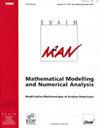New mixed finite element methods for the coupled Stokes and Poisson–Nernst–Planck equations in Banach spaces
IF 1.9
3区 数学
Q2 Mathematics
Esaim-Mathematical Modelling and Numerical Analysis-Modelisation Mathematique et Analyse Numerique
Pub Date : 2023-03-15
DOI:10.1051/m2an/2023024
引用次数: 5
Abstract
In this paper we employ a Banach spaces-based framework to introduce and analyze new mixed finite element methods for the numerical solution of the coupled Stokes and Poisson–Nernst–Planck equations, which is a nonlinear model describing the dynamics of electrically charged incompressible fluids. The pressure of the fluid is eliminated from the system (though computed afterwards via a postprocessing formula) thanks to the incompressibility condition and the incorporation of the fluid pseudostress as an auxiliary unknown. In turn, besides the electrostatic potential and the concentration of ionized particles, we use the electric field (rescaled gradient of the potential) and total ionic fluxes as new unknowns. The resulting fully mixed variational formulation in Banach spaces can be written as a coupled system consisting of two saddle-point problems, each one with nonlinear source terms depending on the remaining unknowns, and a perturbed saddlepoint problem with linear source terms, which is in turn additionally perturbed by a bilinear form. The well-posedness of the continuous formulation is a consequence of a fixed-point strategy in combination with the Banach theorem, the Babuˇska–Brezzi theory, the solvability of abstract perturbed saddle-point problems, and the Banach–Neˇcas–Babuˇska theorem. For this we also employ smallness assumptions on the data. An analogous approach, but using now both the Brouwer and Banach theorems, and invoking suitable stability conditions on arbitrary finite element subspaces, is employed to conclude the existence and uniqueness of solution for the associated Galerkin scheme. A priori error estimates are derived, and examples of discrete spaces that fit the theory, include, e.g., Raviart–Thomas elements of order k along with piecewise polynomials of degree ďk. Finally, rates of convergence are specified and several numerical experiments confirm the theoretical error bounds. These tests also illustrate the balance-preserving properties and applicability of the proposed family of methods.Banach空间中Stokes和Poisson-Nernst-Planck耦合方程的混合有限元新方法
本文采用基于Banach空间的框架,引入并分析了用于描述带电不可压缩流体动力学的非线性模型Stokes和Poisson-Nernst-Planck耦合方程数值解的混合有限元新方法。由于不可压缩性条件和流体伪应力作为辅助未知数的结合,流体的压力从系统中消除(尽管随后通过后处理公式计算)。反过来,除了静电势和电离粒子的浓度外,我们还使用电场(势的重新标度梯度)和总离子通量作为新的未知数。由此得到的Banach空间中的完全混合变分公式可以写成由两个鞍点问题组成的耦合系统,每个鞍点问题都具有依赖于剩余未知数的非线性源项,以及一个具有线性源项的扰动鞍点问题,该问题反过来又被双线性形式扰动。连续公式的适定性是与Banach定理、Babu - ska - brezzi理论、抽象摄动鞍点问题的可解性以及Banach - ne - cas-Babu - ska定理相结合的不动点策略的结果。为此,我们还对数据采用了较小的假设。利用Brouwer定理和Banach定理,并在任意有限元子空间上调用合适的稳定性条件,用一种类似的方法得出了相关Galerkin格式解的存在唯一性。推导了先验误差估计,以及适合该理论的离散空间的示例,包括,例如,k阶的Raviart-Thomas元素以及阶为ďk的分段多项式。最后,给出了收敛速度,并通过数值实验验证了理论误差范围。这些测试还说明了所提出的方法族的保平衡特性和适用性。
本文章由计算机程序翻译,如有差异,请以英文原文为准。
求助全文
约1分钟内获得全文
求助全文
来源期刊

CiteScore
2.70
自引率
5.30%
发文量
27
审稿时长
6-12 weeks
期刊介绍:
M2AN publishes original research papers of high scientific quality in two areas: Mathematical Modelling, and Numerical Analysis. Mathematical Modelling comprises the development and study of a mathematical formulation of a problem. Numerical Analysis comprises the formulation and study of a numerical approximation or solution approach to a mathematically formulated problem.
Papers should be of interest to researchers and practitioners that value both rigorous theoretical analysis and solid evidence of computational relevance.
 求助内容:
求助内容: 应助结果提醒方式:
应助结果提醒方式:


